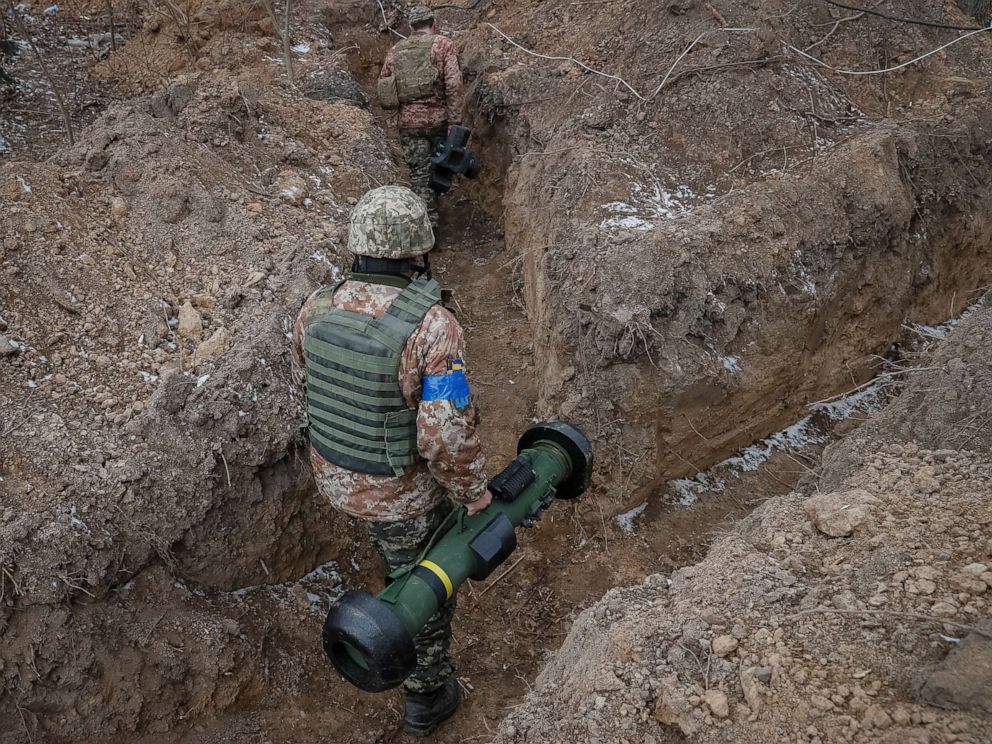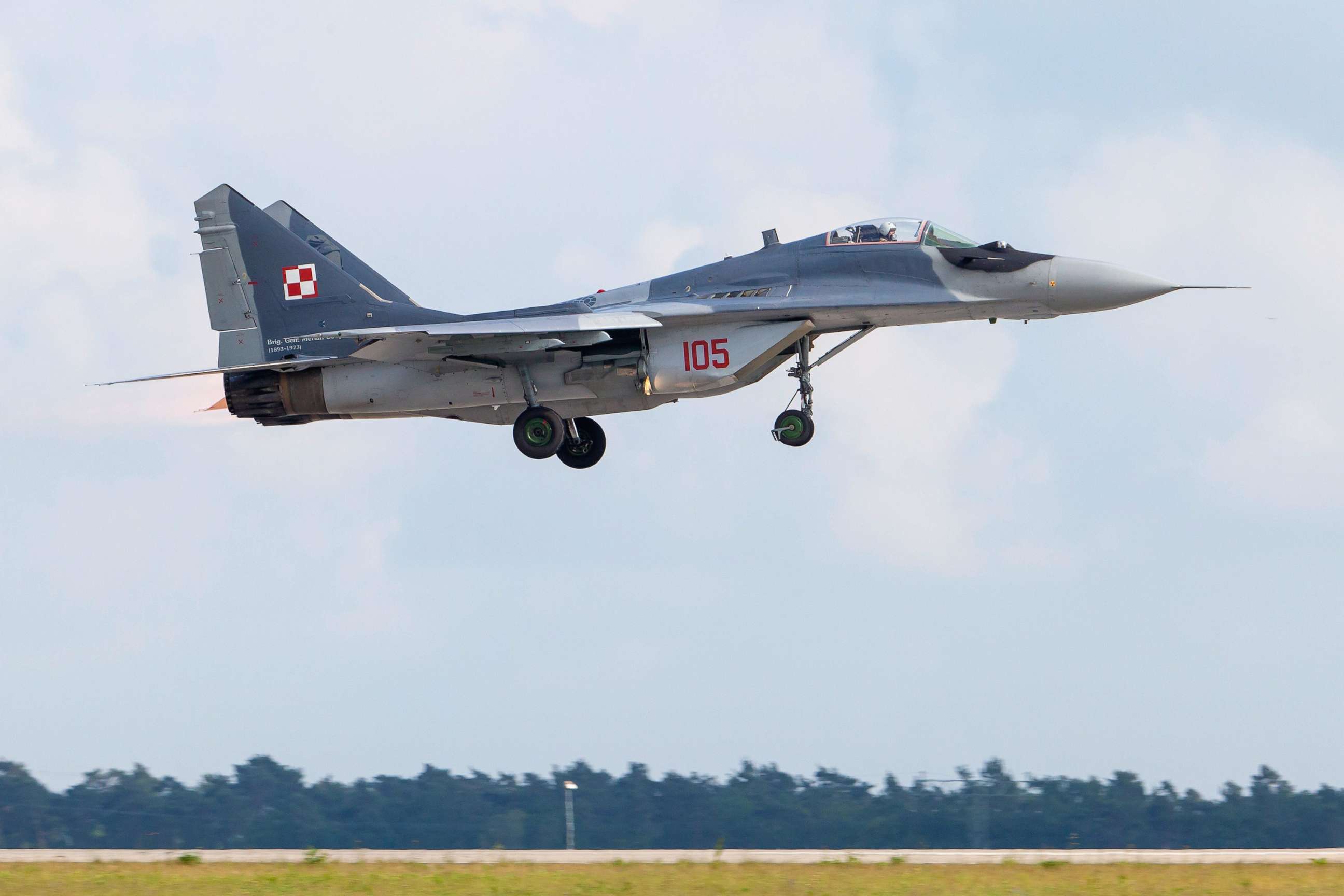Message to Moscow: Biden boosts military aid to Ukraine in public display: ANALYSIS
Just weeks ago, the U.S. had refused to detail what weapons it was providing.
Hours after an emotional address to Congress by Ukrainian President Volodymyr Zelenskyy, where he pleaded for a no-fly zone and more lethal U.S. aid, President Joe Biden on Wednesday announced the U.S. is increasing its supply of missiles, firearms, and now drones to Ukraine in a public display.
The White House has now detailed exactly what weaponry the U.S. is providing -- when just weeks ago U.S. officials refused to say.
The message is meant to not only reassure Ukraine of strong U.S. support, but also send a message to Moscow that it will pay a bloody price for its invasion of its neighbor.
"The American people are answering President Zelenskyy's call for more help, more weapons for Ukraine to defend itself, more tools to fight Russian aggression, and that's what we're doing," Biden said in an address Wednesday.

That increase comes after intense pressure from Kyiv, as well as Washington, where lawmakers of both parties have urged Biden to escalate U.S. military support.
But the president has repeatedly cautioned against crossing certain lines, saying they would lead to "World War III." Among them, the administration has ruled out implementing a no-fly zone, sending U.S. troops into Ukrainian territory, or having the U.S. directly provide Soviet-era warplanes from NATO allies like Poland.
Instead, Biden said that an initial tranche of $800 million -- from the nearly $14 billion Congress approved in humanitarian and military aid for Ukraine -- would include 800 Stinger anti-aircraft missiles, 100 Switchblade drones, and 9,000 anti-armor missiles, including 2,000 Javelin anti-tank missiles.
The Switchblade drone is the newest form of lethal assistance -- a small kamikaze-style drone launched from a tube that can track and attack armored targets.
Ukrainian armed forces have made powerful use of drones in their fight against invading Russian forces already, although some military analysts say the Switchblade is not powerful enough and the U.S. isn't sending enough of them.
"The Switchblade is a capable system, but has its drawbacks compared to some more modern versions of 'loitering munitions'... that you can return to base and re-use," said retired Gen. Robert Abrams, former chief of U.S. Forces Korea and now an ABC News analyst.

To date, Ukraine has received thousands of Javelin missiles from the U.S. and other NATO allies, according to a U.S. official -- including approximately 2,600 from the U.S., the White House announced Wednesday.
Javelins were once seen as too escalatory by the Obama administration to provide Ukraine after Russia first invaded its smaller, democratic neighbor in 2014, seizing the Crimean Peninsula and sparking a separatist war in the eastern provinces Donetsk and Luhansk.
Now, the White House is confirming not just the delivery of thousands of them, but of hundreds of Stinger missiles, too -- something it wouldn't confirm it was delivering even days into the war.
Still, there are many who say more must be done, from U.S. lawmakers to Ukrainian officials to leaders of NATO countries in the alliance's eastern flank.
After meeting Zelenskyy in Kyiv, for example, Jaroslaw Kaczynski, the powerful leader of Poland's ruling party who serves as deputy prime minister, told reporters an international peacekeeping mission should be sent to Ukraine, with the means to defend itself.
U.S. officials have ruled that out, starting with Biden and stretching to include Republican lawmakers.
"[A] NATO no-fly zone seems to be a bridge too far for me and the administration," said Sen. Lindsey Graham, R-S.C.
But he added that "there is bipartisan support for sending a package that includes fighter jets and air defense systems to Ukraine immediately so that we can have a Ukrainian no-fly zone manned by Ukrainian pilots and manned by missile systems in the hands of the Ukrainian military."

The administration is consulting with U.S. allies that have more advanced missile systems than the shoulder-fired Stingers and Javelins that have been provided so far, according to State Department and Pentagon officials. In particular, there are talks to resupply Soviet-era or Russian-made missile systems, they said -- such as the S-300 missile battery.
"Those are the systems on which they're already using, the systems on which they're already trained and have actually demonstrated great effect already," State Department spokesperson Ned Price told reporters Wednesday.
Only three NATO allies have the S-300 -- Greece, Bulgaria, and Slovakia. Biden's national security adviser Jake Sullivan spoke on Wednesday to his Greek counterpart, Dr. Thanos Dokos, including about "international efforts ... to ensure Ukraine has the ability to defend itself," the White House said.
But the Pentagon has rejected an idea from Poland to have Polish Soviet-era warplanes known as MiG-29s transferred to U.S. custody and then passed onto Ukraine, saying a U.S. intelligence assessment warned the move would be seen as too escalatory by the Kremlin.
"The equipment that we provided is defensive, as you know, not offensive, and we see that as being a difference," White House press secretary Jen Psaki said Wednesday.
To some, any lethal U.S. aid may be seen as crossing Putin's red line after the strongman leader warned the world that countries interfering in his so-called "special military operation" would face "consequences you have never seen."

U.S. officials have said they're still encouraging other countries to provide warplanes directly, but lawmakers continue to press the White House to get involved, especially after Zelenskyy's address.
"Never in the history of warfare have 28 planes meant so much to so many," said Graham Wednesday.
Ukraine already has a fleet of MiG-29s that the Pentagon has said they are not using often in part because Russia has not dominated the country's airspace.
In addition, fewer than half of Poland's planes may be flyable, according to retired Gen. Joseph Ralston, the former commander of U.S. European Command and Supreme Allied Commander Europe. The Soviet-era planes require spare parts from Russia -- out of the question in the current conflict -- and constant maintenance, although providing their spare parts to the Ukrainians now be helpful, he said.
"The MiG-29 issue has taken on more of a symbolic issue than it is a real-world issue," Ralston said during an event at the Center for Strategic and International Studies, a Washington think tank.
While the White House has publicly touted this aid in the midst of pressure to do more, it's been very tight-lipped about how it is getting into Ukrainian hands. Russia has made clear that the delivery of military aid is a potential "target."
"Pumping Ukraine with weapons from a number of countries orchestrated by them is not just a dangerous move, but these are actions that turn the corresponding convoys into legitimate targets," Russian Deputy Foreign Minister Sergei Ryabkov told state-run Channel One news agency.
A strike Sunday in western Ukraine, just 10 miles from the Polish border, has brought that risk home, killing 35 people and injuring more than 100.
"We have to act and act quickly. It's not a matter of weeks, it's a matter of hours and days," said Sen. Rob Portman, R-Ohio.
ABC News' Luis Martinez contributed to this report from the Pentagon and Trish Turner from Capitol Hill.




